Abstract
Inhibitory effects of the sustained delivery systems (microcapsules and microgranules) of a potent antagonist of luteinizing hormone-releasing hormone N-Ac-[3-(2-naphthyl)-D-alanine1, 4-chloro-D-phenylalanine2, 3-(3-pyridyl)-D-alanine3, D-citrulline6, D-alanine10]LH-RH (SB-75) on the growth of experimental prostate cancers were investigated. In the first experiment, three doses of a microcapsule preparation releasing 23.8, 47.6, and 71.4 micrograms of antagonist SB-75 per day were compared with microcapsules of agonist [D-Trp6]LH-RH liberating 25 micrograms/day in rats bearing Dunning R3327H transplantable prostate carcinoma. During 8 weeks of treatment, tumor growth was decreased by [D-Trp6]LH-RH and all three doses of SB-75 as compared to untreated controls. The highest dose of SB-75 (71.4 micrograms/day) caused a greater inhibition of prostate cancer growth than [D-Trp6]LH-RH as based on measurement of tumor volume and percentage change in tumor volume. Doses of 23.8 and 47.6 micrograms of SB-75 per day induced a partial and submaximal decrease, respectively, in tumor weight and volume. Tumor doubling time was the longest (50 days) with the high dose of SB-75 vs. 15 days for controls. The body weights were unchanged. The weights of testes, seminal vesicles, and ventral prostate were greatly reduced in all three groups that received SB-75, and testosterone levels were decreased to nondetectable values in the case of the two higher doses of SB-75. LH levels were also diminished. Similar results were obtained in the second experiment, in which the animals were treated for a period of 8 weeks with microgranules of SB-75. Therapy with microgranules of SB-75 significantly decreased tumor growth as measured by the final tumor volume, the percentage change from the initial tumor volume, and the reduction in tumor weight. The results indicate that antagonist SB-75, released from sustained delivery systems, can produce a state of chemical castration and effectively inhibit the growth of experimental prostate cancers. The efficacy of the antagonist SB-75 in inhibiting androgen-dependent Dunning prostatic carcinoma and the absence of side effects suggest its possible usefulness for the treatment of hormone-sensitive tumors.
Full text
PDF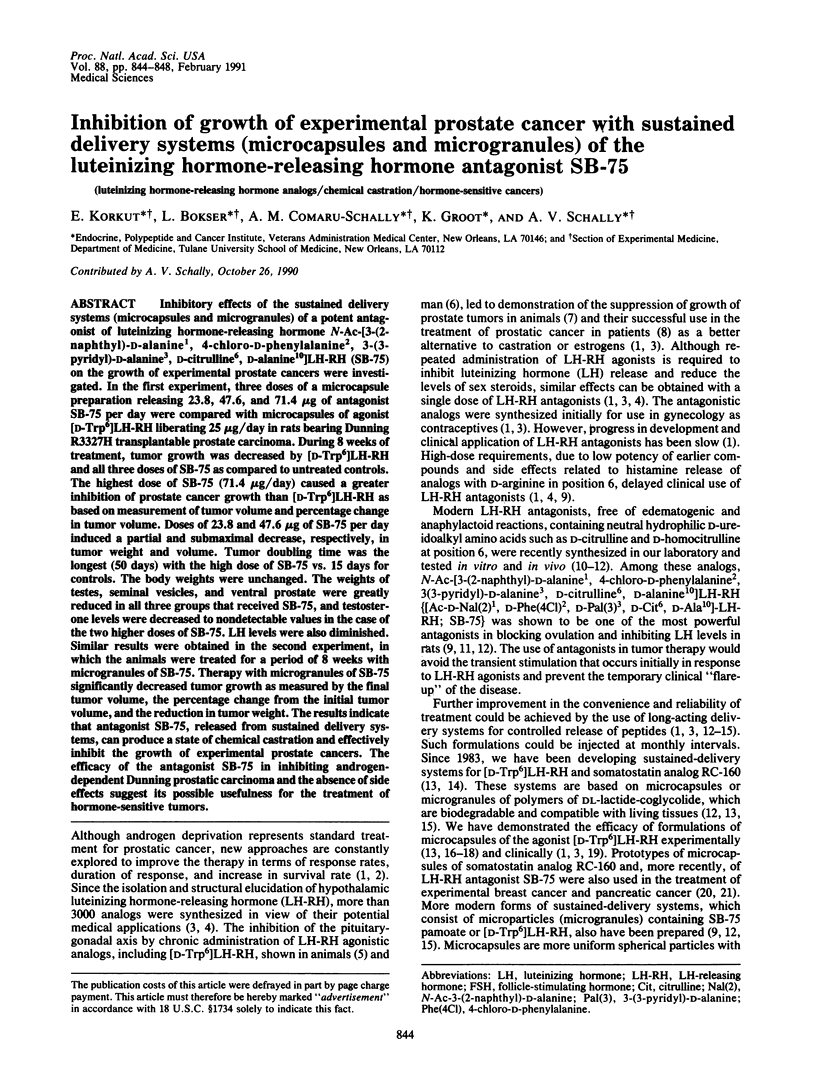
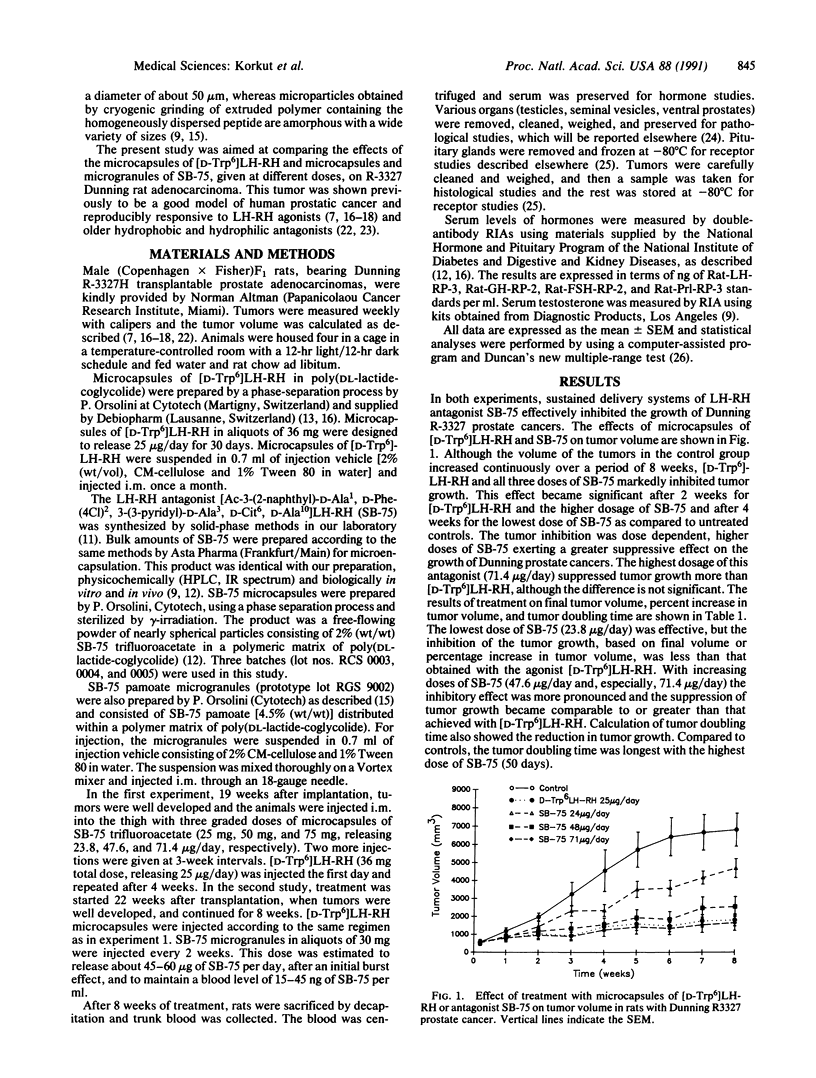
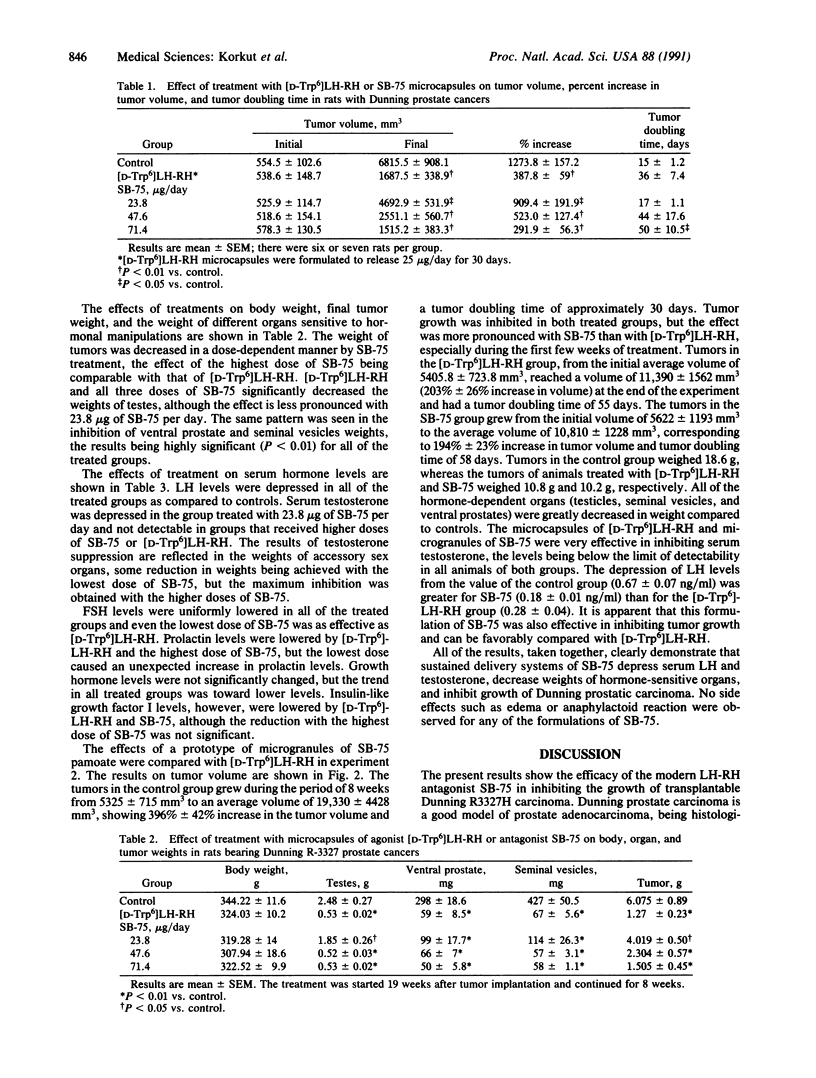
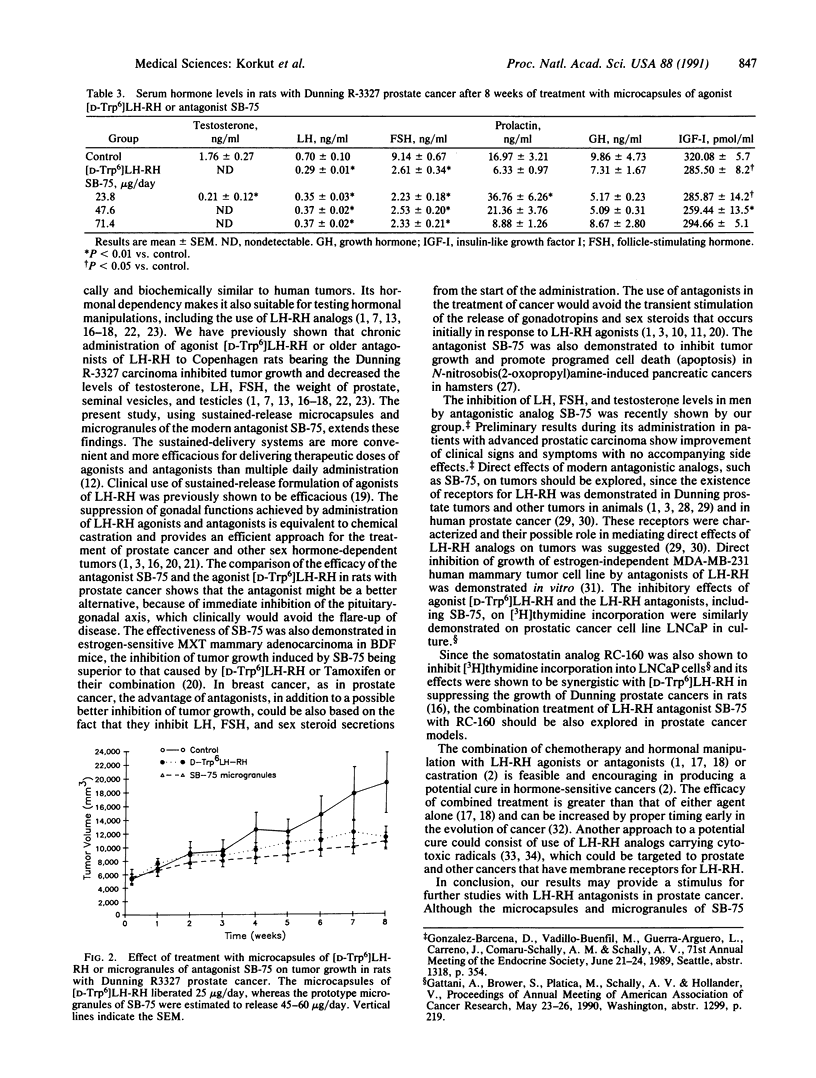
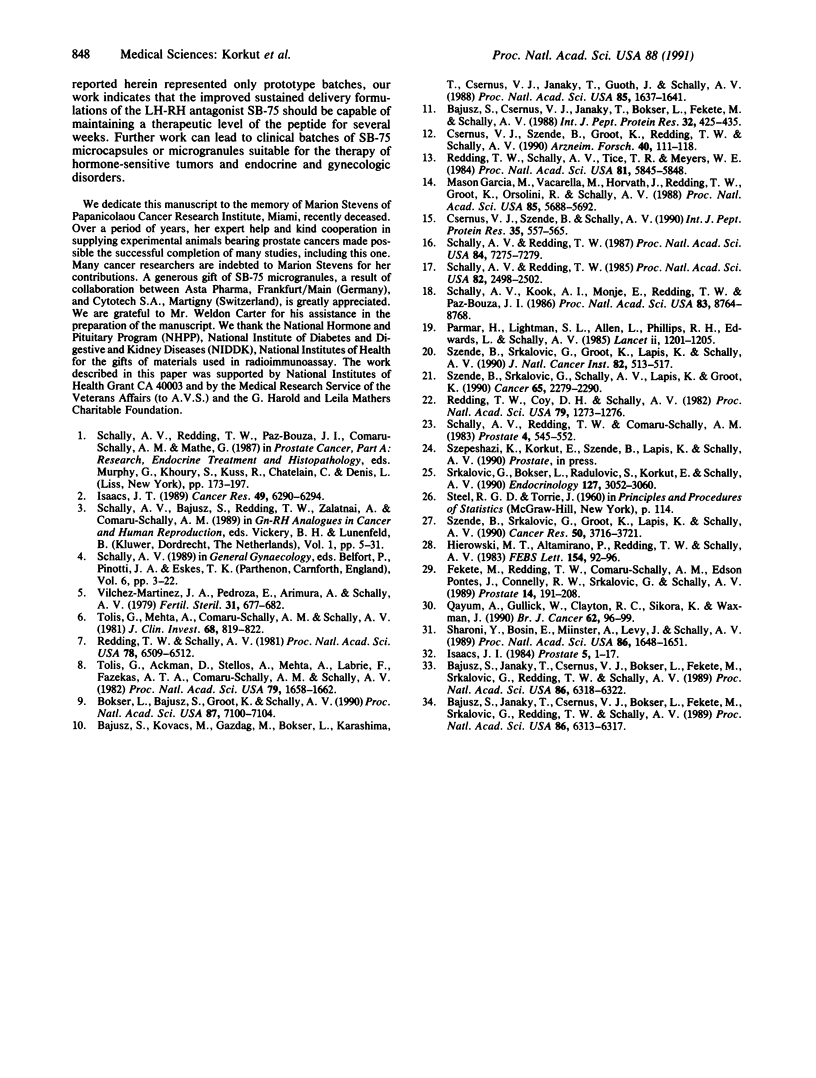
Selected References
These references are in PubMed. This may not be the complete list of references from this article.
- Bajusz S., Csernus V. J., Janaky T., Bokser L., Fekete M., Schally A. V. New antagonists of LHRH. II. Inhibition and potentiation of LHRH by closely related analogues. Int J Pept Protein Res. 1988 Dec;32(6):425–435. doi: 10.1111/j.1399-3011.1988.tb01373.x. [DOI] [PubMed] [Google Scholar]
- Bajusz S., Janaky T., Csernus V. J., Bokser L., Fekete M., Srkalovic G., Redding T. W., Schally A. V. Highly potent analogues of luteinizing hormone-releasing hormone containing D-phenylalanine nitrogen mustard in position 6. Proc Natl Acad Sci U S A. 1989 Aug;86(16):6318–6322. doi: 10.1073/pnas.86.16.6318. [DOI] [PMC free article] [PubMed] [Google Scholar]
- Bajusz S., Janaky T., Csernus V. J., Bokser L., Fekete M., Srkalovic G., Redding T. W., Schally A. V. Highly potent metallopeptide analogues of luteinizing hormone-releasing hormone. Proc Natl Acad Sci U S A. 1989 Aug;86(16):6313–6317. doi: 10.1073/pnas.86.16.6313. [DOI] [PMC free article] [PubMed] [Google Scholar]
- Bajusz S., Kovacs M., Gazdag M., Bokser L., Karashima T., Csernus V. J., Janaky T., Guoth J., Schally A. V. Highly potent antagonists of luteinizing hormone-releasing hormone free of edematogenic effects. Proc Natl Acad Sci U S A. 1988 Mar;85(5):1637–1641. doi: 10.1073/pnas.85.5.1637. [DOI] [PMC free article] [PubMed] [Google Scholar]
- Bokser L., Bajusz S., Groot K., Schally A. V. Prolonged inhibition of luteinizing hormone and testosterone levels in male rats with the luteinizing hormone-releasing hormone antagonist SB-75. Proc Natl Acad Sci U S A. 1990 Sep;87(18):7100–7104. doi: 10.1073/pnas.87.18.7100. [DOI] [PMC free article] [PubMed] [Google Scholar]
- Csernus V. J., Szende B., Groot K., Redding T. W., Schally A. V. Development of radioimmunoassay for a potent luteinizing hormone-releasing hormone antagonist. Evaluation of serum levels after injection of [Ac-3-(2-naphthyl)-D-Ala1, D-Phe(pCl)2, 3-(3-pyridyl)-D-Ala3, D-Cit6, D-Ala10] LHRH. Arzneimittelforschung. 1990 Feb;40(2 Pt 1):111–118. [PubMed] [Google Scholar]
- Csernus V. J., Szende B., Schally A. V. Release of peptides from sustained delivery systems (microcapsules and microparticles) in vivo. A histological and immunohistochemical study. Int J Pept Protein Res. 1990 Jun;35(6):557–565. doi: 10.1111/j.1399-3011.1990.tb00262.x. [DOI] [PubMed] [Google Scholar]
- Fekete M., Redding T. W., Comaru-Schally A. M., Pontes J. E., Connelly R. W., Srkalovic G., Schally A. V. Receptors for luteinizing hormone-releasing hormone, somatostatin, prolactin, and epidermal growth factor in rat and human prostate cancers and in benign prostate hyperplasia. Prostate. 1989;14(3):191–208. doi: 10.1002/pros.2990140302. [DOI] [PubMed] [Google Scholar]
- Hierowski M. T., Altamirano P., Redding T. W., Schally A. V. The presence of LHRH-like receptors in Dunning R3327H prostate tumors. FEBS Lett. 1983 Apr 5;154(1):92–96. doi: 10.1016/0014-5793(83)80881-3. [DOI] [PubMed] [Google Scholar]
- Isaacs J. T. Relationship between tumor size and curability of prostatic cancer by combined chemo-hormonal therapy in rats. Cancer Res. 1989 Nov 15;49(22):6290–6294. [PubMed] [Google Scholar]
- Isaacs J. T. The timing of androgen ablation therapy and/or chemotherapy in the treatment of prostatic cancer. Prostate. 1984;5(1):1–17. doi: 10.1002/pros.2990050102. [DOI] [PubMed] [Google Scholar]
- Mason-Garcia M., Vaccarella M., Horvath J., Redding T. W., Groot K., Orsolini P., Schally A. V. Radioimmunoassay for octapeptide analogs of somatostatin: measurement of serum levels after administration of long-acting microcapsule formulations. Proc Natl Acad Sci U S A. 1988 Aug;85(15):5688–5692. doi: 10.1073/pnas.85.15.5688. [DOI] [PMC free article] [PubMed] [Google Scholar]
- Parmar H., Phillips R. H., Lightman S. L., Edwards L., Allen L., Schally A. V. Randomised controlled study of orchidectomy vs long-acting D-Trp-6-LHRH microcapsules in advanced prostatic carcinoma. Lancet. 1985 Nov 30;2(8466):1201–1205. doi: 10.1016/s0140-6736(85)90739-1. [DOI] [PubMed] [Google Scholar]
- Qayum A., Gullick W., Clayton R. C., Sikora K., Waxman J. The effects of gonadotrophin releasing hormone analogues in prostate cancer are mediated through specific tumour receptors. Br J Cancer. 1990 Jul;62(1):96–99. doi: 10.1038/bjc.1990.236. [DOI] [PMC free article] [PubMed] [Google Scholar]
- Redding T. W., Coy D. H., Schally A. V. Prostate carcinoma tumor size in rats decreases after administration of antagonists of luteinizing hormone-releasing hormone. Proc Natl Acad Sci U S A. 1982 Feb;79(4):1273–1276. doi: 10.1073/pnas.79.4.1273. [DOI] [PMC free article] [PubMed] [Google Scholar]
- Redding T. W., Schally A. V. Inhibition of prostate tumor growth in two rat models by chronic administration of D-Trp6 analogue of luteinizing hormone-releasing hormone. Proc Natl Acad Sci U S A. 1981 Oct;78(10):6509–6512. doi: 10.1073/pnas.78.10.6509. [DOI] [PMC free article] [PubMed] [Google Scholar]
- Redding T. W., Schally A. V., Tice T. R., Meyers W. E. Long-acting delivery systems for peptides: inhibition of rat prostate tumors by controlled release of [D-Trp6]luteinizing hormone-releasing hormone from injectable microcapsules. Proc Natl Acad Sci U S A. 1984 Sep;81(18):5845–5848. doi: 10.1073/pnas.81.18.5845. [DOI] [PMC free article] [PubMed] [Google Scholar]
- Schally A. V., Kook A. I., Monje E., Redding T. W., Paz-Bouza J. I. Combination of a long-acting delivery system for luteinizing hormone-releasing hormone agonist with Novantrone chemotherapy: increased efficacy in the rat prostate cancer model. Proc Natl Acad Sci U S A. 1986 Nov;83(22):8764–8768. doi: 10.1073/pnas.83.22.8764. [DOI] [PMC free article] [PubMed] [Google Scholar]
- Schally A. V., Redding T. W., Comaru-Schally A. M. Inhibition of prostate tumors by agonistic and antagonistic analogs of LH-RH. Prostate. 1983;4(6):545–552. doi: 10.1002/pros.2990040602. [DOI] [PubMed] [Google Scholar]
- Schally A. V., Redding T. W. Combination of long-acting microcapsules of the D-tryptophan-6 analog of luteinizing hormone-releasing hormone with chemotherapy: investigation in the rat prostate cancer model. Proc Natl Acad Sci U S A. 1985 Apr;82(8):2498–2502. doi: 10.1073/pnas.82.8.2498. [DOI] [PMC free article] [PubMed] [Google Scholar]
- Schally A. V., Redding T. W., Paz-Bouza J. I., Comaru-Schally A. M., Mathe G. Current concept for improving treatment of prostate cancer based on combination of LH-RH agonists with other agents. Prog Clin Biol Res. 1987;243A:173–197. [PubMed] [Google Scholar]
- Schally A. V., Redding T. W. Somatostatin analogs as adjuncts to agonists of luteinizing hormone-releasing hormone in the treatment of experimental prostate cancer. Proc Natl Acad Sci U S A. 1987 Oct;84(20):7275–7279. doi: 10.1073/pnas.84.20.7275. [DOI] [PMC free article] [PubMed] [Google Scholar]
- Sharoni Y., Bosin E., Miinster A., Levy J., Schally A. V. Inhibition of growth of human mammary tumor cells by potent antagonists of luteinizing hormone-releasing hormone. Proc Natl Acad Sci U S A. 1989 Mar;86(5):1648–1651. doi: 10.1073/pnas.86.5.1648. [DOI] [PMC free article] [PubMed] [Google Scholar]
- Srkalovic G., Bokser L., Radulovic S., Korkut E., Schally A. V. Receptors for luteinizing hormone-releasing hormone (LHRH) in Dunning R3327 prostate cancers and rat anterior pituitaries after treatment with a sustained delivery system of LHRH antagonist SB-75. Endocrinology. 1990 Dec;127(6):3052–3060. doi: 10.1210/endo-127-6-3052. [DOI] [PubMed] [Google Scholar]
- Szende B., Srkalovic G., Groot K., Lapis K., Schally A. V. Growth inhibition of mouse MXT mammary tumor by the luteinizing hormone-releasing hormone antagonist SB-75. J Natl Cancer Inst. 1990 Mar 21;82(6):513–517. doi: 10.1093/jnci/82.6.513. [DOI] [PubMed] [Google Scholar]
- Szende B., Srkalovic G., Groot K., Lapis K., Schally A. V. Regression of nitrosamine-induced pancreatic cancers in hamsters treated with luteinizing hormone-releasing hormone antagonists or agonists. Cancer Res. 1990 Jun 15;50(12):3716–3721. [PubMed] [Google Scholar]
- Szende B., Srkalovic G., Schally A. V., Lapis K., Groot K. Inhibitory effects of analogs of luteinizing hormone-releasing hormone and somatostatin on pancreatic cancers in hamsters. Events that accompany tumor regression. Cancer. 1990 May 15;65(10):2279–2290. doi: 10.1002/1097-0142(19900515)65:10<2279::aid-cncr2820651020>3.0.co;2-3. [DOI] [PubMed] [Google Scholar]
- Tolis G., Ackman D., Stellos A., Mehta A., Labrie F., Fazekas A. T., Comaru-Schally A. M., Schally A. V. Tumor growth inhibition in patients with prostatic carcinoma treated with luteinizing hormone-releasing hormone agonists. Proc Natl Acad Sci U S A. 1982 Mar;79(5):1658–1662. doi: 10.1073/pnas.79.5.1658. [DOI] [PMC free article] [PubMed] [Google Scholar]
- Tolis G., Mehta A., Comaru-Schally A. M., Schally A. V. Suppression of androgen production by D-tryptophan-6-luteinizing hormone-releasing hormone in man. J Clin Invest. 1981 Sep;68(3):819–822. doi: 10.1172/JCI110320. [DOI] [PMC free article] [PubMed] [Google Scholar]
- Vilchez-Martinez J. A., Pedroza E., Arimura A., Schally A. V. Paradoxical effects of D-Trp6-luteinizing hormone-releasing hormone on the hypothalamic-pituitary-gonadal axis in immature female rats. Fertil Steril. 1979 Jun;31(6):677–682. doi: 10.1016/s0015-0282(16)44061-6. [DOI] [PubMed] [Google Scholar]


